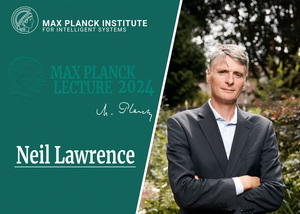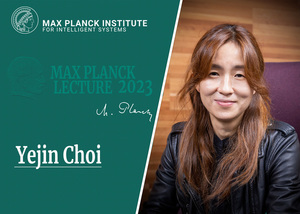Max Planck Lectures
The Max Planck lecture is given by outstanding scientists and internationally recognized leaders in their field.
The Max Planck Lecture was created in 2003 by the Stuttgart Max Planck Institutes and features invited speakers who are world-leading experts in their fields. The lecture is held every six months on the Max Planck Campus in Stuttgart and is jointly organized by the Institutes for Solid State Research (FKF) and for Intelligent Systems (IS) (former Metals Research) who take turns inviting a renowned scientist and expert in her/his field as a speaker. The lecture is aimed at colleagues from science, project partners from industry, policy makers, and persons with an interest in science.
The Atomic Human: Understanding ourselves in the age of AI
- 17 October 2024 • 16:00—18:00
- Neil Lawrence
- Lecture Hall 2D5, Heisenbergstraße 1, Stuttgart
By contrasting our own (evolved, locked-in, embodied) intelligence with the capabilities of machine intelligence through history, The Atomic Human reveals the technical origins, capabilities and limitations of AI systems, and how they should be wielded. Not just by the experts, but ordinary people. Either AI is a tool for us, or we become a tool of AI. Understanding this will enable us to choose the future we want.
Organizers: Michael Black Barbara Kettemann Valeria Rojas
Common Sense: the Dark Matter of Language and Intelligence
- 26 May 2023 • 14:30—18:00
- Yejin Choi
- Tübingen, N 0.002
Herzliche Einladung zur Max Planck Lecture 2023 in Tübingen.
Organizers: Moritz Hardt Michael Black Bernhard Schölkopf Matthias Tröndle Barbara Kettemann Nisha Tyagi
- Zhenan Bao
- Stuttgart
Zhenan Bao is an inspiring scientist who is a world-renowned chemist, chemical engineer and material scientist and who has received so many awards it becomes challenging to count. She teaches at Stanford University in the heart of Silicon Valley where she and her team develop the most dazzling flexible and stretchable materials, electronics and energy devices which are inspired by human skin. On Friday, July 22, 2022 from 1:30pm, Zhenan Bao will hold this year’s Max Planck Lecture titled "Skin-Inspired Organic Electronics" at the Stuttgart site of the MPI-IS – live and in-person just as before the pandemic.
Organizers: Metin Sitti Matthias Tröndle Barbara Kettemann
Understanding and tuning the surface chemistry of perovskite oxides to activate oxygen exchange and water splitting reactions
- 10 March 2022
- Professor Bilge Yildiz
- Stuttgart / FKF
The deployment of decarbonization technologies, including solid oxide fuel and electrolysis cells, is limited by slow rates of conversion reactions at surfaces, and instability of materials under operating conditions. A major scientific challenge has been the lack of knowledge of the chemistry and electronic structure on material surfaces in the harsh operational conditions.
Machine Learning for Covid-19 Risk Awareness from Contact Tracing
- 23 June 2020 • 17:30
- Yoshua Bengio
- Virtual Event
The Covid-19 pandemic has spread rapidly worldwide, overwhelming manual contact tracing in many countries, resulting in widespread lockdowns for emergency containment. Large-scale digital contact tracing (DCT) has emerged as a potential solution to resume economic and social activity without triggering a second outbreak. Various DCT methods have been proposed, each making trade-offs between privacy, mobility restriction, and public health.
Organizers: Michael Black Bernhard Schölkopf Oliwia Gust
- Roland Siegwart
- MPI-IS, Lecture Hall 2D5, Heisenbergstraße 1, Stuttgart
While robots are already doing a wonderful job as factory workhorses, they are now gradually appearing in our daily environments and offering their services as autonomous cars, delivery drones, helpers in search and rescue and much more. This talk will present some recent highlights in the field of autonomous mobile robotics research and touch on some of the great challenges and opportunities. Legged robots are able to overcome the limitations of wheeled or tracked ground vehicles. ETH’s electrically powered legged quadruped robots are designed for high agility, efficiency and robustness in rough terrain. This is realized through an optimal exploitation of the natural dynamics and serial elastic actuation. For fast inspection of complex environments, flying robots are probably the most efficient and versatile devices. However, the limited payload and computing power of drones renders autonomous navigation quite challenging. Thanks to our custom designed visual-inertial sensor, real-time on-board localization, mapping and planning has become feasible and enables our multi-copters and solar-powered fixed wing drones for advanced rescue and inspection tasks or support in precision farming, even in GPS-denied environments.
Organizers: Katherine Kuchenbecker Matthias Tröndle Ildikó Papp-Wiedmann Barbara Kettemann
Transparent Amorphous Oxide Semiconductors: from materials design to implementation to state of the art displays
- 12 October 2018
- Prof. Dr. Hideo Hosono
- FKF
Thin film transistor (TFTs) is a fundamental building block in electronic circuits. Since the specification for TFTs to drive the pixel of flat panel displays rather differs from that for CPUs and memories because of their large dimension.
- Prof. Amnon Shashua
- MPI-IS
The field of transportation is undergoing a seismic change with the coming introduction of autonomous driving. The technologies required to enable computer driven cars involves the latest cutting edge artificial intelligence algorithms along three major thrusts: Sensing, Planning and Mapping. Prof. Amnon Shashua, Co-founder and Chairman of Mobileye, will describe the challenges and the kind of machine learning algorithms involved, but will do that through the perspective of Mobileye’s activity in this domain.
- Robert J. Birgeneau
- FKF
Solid State Physics is a field which continuously renews itself through the discovery of new materials and new phenomena. This has been particularly true for the subfield of superconductivity.
On the Nonlinear Dynamics of Collective Decision-Making in Nature and Design
- 06 June 2016
- Professor Naomi Ehrich Leonard
- MPI-IS
The successful deployment of complex, multi-agent systems requires well-designed, agent-level control strategies that accommodate sensing, communication, and computational limitations on individual agents.
Ultracold atoms as quantum simulators for new materials – synthetic magnetic fields and topological phases
- 20 May 2015
- Professor Wolfgang Ketterle
- FKF
When atoms are cooled to nanokelvin temperatures, they can easily be confined and manipulated with laser beams. Their interactions can be tuned with the help of magnetic fields, making them strongly or weakly interacting, repulsive or attractive.
- Vijay Kumar, Ph.D.
- MPI-IS
Autonomous micro aerial robots can operate in three-dimensional, indoor and outdoor environments, and have applications to search and rescue, first response and precision farming. I will describe the challenges in developing small, agile robots and the algorithmic challenges in the areas of (a) control and planning, (b) state estimation and mapping, and (c) coordinating large teams of robots.
The Glassy State properties and applications exploiting non-crystallinity: golf, frozen frogs, memory
- 22 May 2014
- Professor A. L. Greer
- MPI-IS
Glasses, lacking the order of crystals, are in many ways still regarded as poorly understood. Yet glasses, lacking the complications of different crystallographic symmetries, also show some remarkable correlations of diverse properties.
- Prof. Dr. Paul Chaikin
- MPI-IS
No one has successfully defined life but the properties we often associate with living things are motility, metabolism and self-replication. According to the Nobel Laureate Richard Feynman: "What I can't create, I don't understand". We thought we'd give it a shot – understanding life – and in the process we've made two different systems, one that exhibits both autonomous motility and metabolism and another which is the first artificial system which can replicate arbitrarily designed motifs.
- Dr. Ivan Božović
- FKF
Interface Science. The last decade has witnessed explosive growth of research on various oxide heterostructures, and discoveries of exciting new interface phenomena. We may be witnessing the emergence of a new scientific discipline – Interface Science, delineated by a distinct new set of problems, techniques, phenomena, and theoretical concepts.
Following Function in Real Time: New NMR, MRI and Diffraction Methods for Studying Structure and Dynamics in Batteries and Supercapacitors
- 06 December 2012
- Prof. Dr. Clare P. Grey
- FKF
A full understanding of the operation of a device requires that we utilize methods that allow devices or materials to be probed while they are operating (i.e., in-situ). This allows, for example, the transformations of the various cell components to be followed under realistic conditions without having to disassemble and take apart the cell.
- Prof. Dr. Robert Wood
- MPI-IS
As the characteristic size of a flying robot decreases, the challenges for successful flight revert to basic questions of fabrication, actuation, fluid mechanics, stabilization, and power – whereas such questions have in general been answered for larger aircraft.
- Prof. Dr. Martin Nowak
- MPI-IS
Cooperation implies that one individual pays a cost for another to receive a benefit. Cost and benefit are measured in terms of reproductive success. Cooperation is useful for construction in evolution: genomes, cells, multi-cellular organisms, animal and human societies are consequences of cooperation. Cooperation can be at variance with natural selection. Why should you help competitors?
- Prof. Dr. Michael Grätzel
- FKF
The field of photovoltaic cells has been dominated so far by solid state p-n junction devices made e.g. of crystalline or amorphous silicon, profiting from the experience and material availability of the semiconductor industry. However, there is an increasing awareness of the possible advantages of devices referred to as "bulk" junctions due to their interconnected three-dimensional structure. Their embodiment departs completely from the conventional flat p-n junction solid-state cells, replacing them by interpenetrating networks.
- Prof. Dr. Subra Suresh
- MPI-MF
This lecture will provide recent research results at the intersections of engineering, materials science, nanotechnology, genetics, life sciences, medicine and public health.
- Prof. Dr. Harold Y. Hwang
- FKF
Complex oxides are fascinating systems which host a vast array of unique phenomena, such as high-temperature (and unconventional) superconductivity, "colossal" magnetoresistance, all forms of magnetism and ferroelectricity, as well as (quantum) phase transitions and couplings between these states.
Architectured Materials and Multifunctional Designs: Foams, Wools and Interlocked Materials
- 08 June 2009
- Prof. Dr. Yves Bréchet
- MPI-MF
Developing new materials via a better understanding of the mechanisms underlying macroscopic properties has been the Graal of materials science. The most prominent effort in Materials Science has been toward a better control of the microstructure, toward smaller and smaller scales, and in recent years, toward nanomaterials.
Electron Interference in two Dimensions: Phase Measurements, Controlled Dephasing and Phase Recovery
- 15 October 2008
- Prof. Dr. Moty Heiblum
- FKF
Electron interference in the solid enables to determine the electron coherence time, the phase electron gains during transport, the statistics of quasi-particles in strongly interacting systems, and the processes of dephasing.
Nanocrystals as Model Systems for Understanding Structural and Chemical Transformations in the Solid State
- 22 July 2008
- Prof. Dr. A. Paul Alivisatos
- MPI-MF
The advent of means to prepare well-controlled nanoscale building blocks has opened up many new opportunities to understand difficult problems which lie at the core of materials science. As an example, nanometer-size inorganic nanocrystals can be transformed from one state to another with remarkably simplified kinetics compared to extended or bulk solids.
- Prof. Dr. Peidong Yang
- FKF
Nanowires are of both fundamental and technological interest. They represent the critical components in the potential nanoscale electronic and photonic device applications.
















